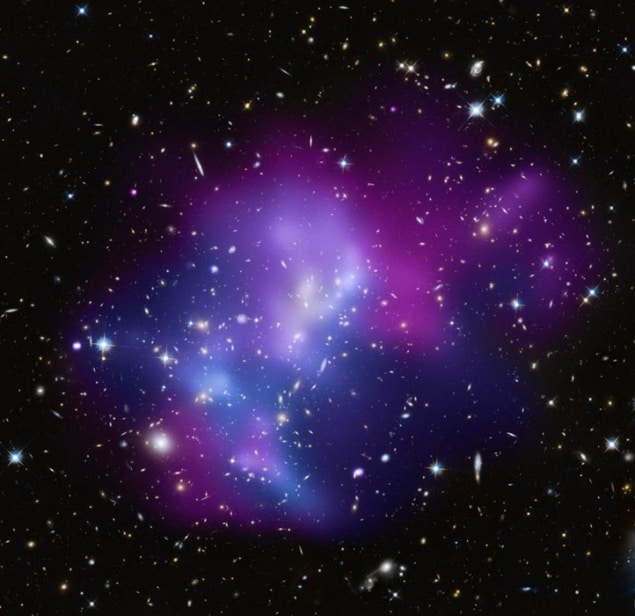
A study of light coming from galaxy clusters has yet again given the thumbs up to the general theory of relativity, Albert Einstein’s famous theory of gravity. Done by physicists in Denmark who measured gravitational redshift, the research appears to rule out some alternative models of gravity – particularly those that deny the existence of dark matter.
Since its publication in 1916, the general theory of relativity has defied all experimental attempts to prove it wrong. In the currently favoured “cosmological constant and cold dark matter” model (ΛCDM) of cosmology, general relativity has successfully explained many aspects of the universe, including the cosmic-microwave background, gravitational lensing and large-scale structure.
However, gravity acting on ordinary matter cannot explain all of the large-scale structure seen in the heavens. Galaxies appear to be bound together with invisible dark matter, which is thought to make up almost a quarter of the entire universe’s mass–energy content. An even less well-understood entity, dark energy, appears to be accelerating the expansion of the universe, and is thought to account for nearly three-quarters of the mass–energy content. Meanwhile, the proportion in the universe of ordinary matter such as atoms seems to be a little under 5%.
Ailing theory
Many physicists expect to understand the nature of dark matter and dark energy in due course. However, others believe that these concepts are merely symptoms of an ailing theory and are looking at alternative models of gravity that can explain observations without invoking dark matter or dark energy. One alternative is modified Newtonian dynamics (MOND), and its generalized partner tensor–vector–scalar (TeVeS) theory, which is supposed to obviate the need for dark matter. Another is f(R) gravity, which does away with dark energy.
Now, Radoslaw Wojtak and colleagues at the University of Copenhagen have used data from the Sloan Digital Sky Survey to test these theories against one another. The study focuses on the gravitational redshift of galaxies within galaxy clusters. This quantity describes how much energy it costs photons to leave a cluster. As they leave and lose energy, the photon wavelengths stretch to the red side of the spectrum. Importantly, the different models of gravity predict different amounts of redshift.
Unfortunately, measuring the gravitational redshift is not easy. There are other sources of redshift including the universe’s expansion and the individual motions of galaxies within a cluster. Wojtak and colleagues therefore calculated the average redshift as a function of distance from the cluster’s centre – a process that should exclude these other sources.
MOND and TeVeS fail
The Copenhagen group discovered that the redshifts agreed with the predictions of both general relativity and f(R) gravity, the theory that tries to avoid dark energy. However, the error bars on the redshifts excluded MOND and TeVeS, the theories that try to avoid dark matter. This backs the conclusions of a separate galaxy study performed earlier this year – but the Copenhagen study has the added clout that it has not been based on any assumptions of the generally accepted ΛCDM model.
“I always find it remarkable how general relativity performs well in all the tests we can conceive,” says Alberto Cappi, an astronomer at the Observatory of Bologna, Italy, who tried to perform a similar study in 1995. “Of course the error bars are large, and it is difficult to see a statistically significant trend…but it is true that the relativistic version of MOND [TeVeS] does not perform well in describing the data.”
‘Punching-bag proxy’
However, other astronomers point out that the Copenhagen group has not necessarily ruled out TeVeS. Hongsheng Zhao of the University of St Andrews, UK, thinks the researchers’ detection is “still in the early stages”, and that there may be other variations of TeVeS they have not looked into. Pedro Ferreira of the University of Oxford, UK, shares this concern. “I am not an advocate of TeVeS – never have been – but it is surprising how it has become the punching-bag proxy for alternative theories of gravity,” he says.
Evan Scannapieco of Arizona State University in Tempe, US, says more data could be the answer. This might come from Euclid, a space telescope planned to be launched by the European Space Agency in 2017. “While there are other reasons to argue against [alternative] gravity models, at this point the constraint from the gravitational redshift of clusters is weak,” says Scannapieco. “More detailed measurements are needed to rule out such models using this approach.”
The study is described in Nature 477 567.



